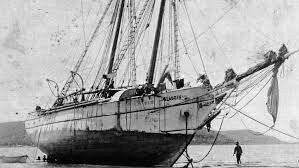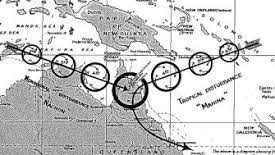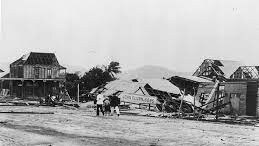Way we were: Cooktown’s day of devastation as two cyclones joined forces in 1899
In a time of poor communication, Cooktown residents knew nothing of what was looming in March, 1899, writes Dot Whittington, but they’ll never forget the aftermath.
Lifestyle
Don't miss out on the headlines from Lifestyle. Followed categories will be added to My News.
It was the perfect storm as two cyclones raced towards the coast north of Cooktown in the first week of March 1899, and with little warning, decimated the Torres Strait pearling fleet and claimed more than 300 lives.
South-easterlies had been blowing and the pearlers were blissfully unaware that cyclone Nachon had crossed the Gulf of Carpentaria in the northwest and Cyclone Mahina was closing in from the northeast over the Coral Sea.
The Brisbane Weather Bureau had noticed a tropical disturbance in the Coral Sea but it had little means of tracking its progress and no way of warning more than 100 vessels from Thursday Island that were working the pearling grounds around Bathurst Bay, 400km south.
Schooners, known as floating stations or depots, serviced a fleet of 10 to 16 luggers. Divers from the luggers would take the pearlshell to the schooner and pick up provisions.
On Saturday, March 4, the luggers were anchored around their schooners and all was well.
Keeping an eye on his barometer, Captain Porter of the schooner Crest of the Wave, predicted a rough night but provided the wind didn’t change, the fleets would be safe in the sheltered anchorage.
The Queensland Government’s Channel Rock lightship, which served as a lighthouse, was nearby, about 3km from Cape Melville, 200km north of Cooktown.

By 10pm, a gale was whipping the sea “mountains high” and torrential rain “hitting as hard as hail” was belting down. The wind blew with hurricane force as the twin cyclones homed in on the pearling fleets in Bathurst Bay and from Cape Melville to Cape Flattery.
The clocks on many boats were found stopped between 3am and 4am, indicating the time they succumbed to the elements. A tidal wave swept along the coast in the early hours of March 5, putting the finishing touches to the trail of destruction.
Captains were powerless against the wind. Within hours, the pearling fleets had been wiped out and the Channel Rock lightship, considered one of the best on the coast, had sunk with its four crew members.
The only survivor of the schooner Silvery Wave said that the captain had cut away the masts when the storm hit but wasn’t seen again. Of 40 boats working near Cape Melville, only one remained afloat.
A lugger drifted 10km with broken masts. Many sank at anchor, others were smashed on the reefs. The sea was strewn with bodies.
On Sunday afternoon the dismasted schooner Crest of the Wave was sighted two miles from Channel Rock flying distress signals. Men, women and children were floating on wreckage. Some got ashore, others died from exposure and drowning.
Bathurst Bay was a forest of mastheads and floating wreckage while tons of dead fish, birds, and reptiles of all descriptions were on the beaches which had “the appearance of a large cemetery”.

“Many porpoises were found at a height of 50ft, having been thrown up by the sea. Stones were embedded in the trees to a depth of 6 inches and rocks weighing tons were thrown up,” witnesses reported.
Two women swam for 10 hours with children on their backs; 15 bodies washed up on a small island; another body, clothed in a diving suit with the headpiece and weighted boots missing, was seen floating high out of the water.
Hero of the 1899 hurricane was Muara Lifu Wacando, a strong young woman from Erub Island, who saved two men from one of the wrecked luggers and swam almost 4km with them supported on her back.
For almost seven hours she battled raging seas before collapsing exhausted on the shore. She became the first Indigenous person to receive the Royal Humane Society’s gold medal.
The gale eased on Monday, but it would be another three days before news of the disaster reached Brisbane: “Hurricane in the north. Eighty-six boats wrecked. Heavy loss of life. A terrible spectacle”. And it was even longer for rescues to be organised.

In all, five schooners and 54 luggers were totally wrecked; three schooners were disabled, 12 luggers sunk, and 307 crew were dead. The final toll was closer to 400 although exact numbers will never be known.
Few vessels were insured. “Past freedom from violent storms had lulled the pearl fishers to sleep,” the Brisbane Courier reported on March 11.
“Yet the thought naturally rises that Nature has shown us what a puny people we are and what a vast country we hold possession of. It has taken nearly a week to apprise the South of a great disaster in the North, and even now we are in the dark as to much that has happened.”


